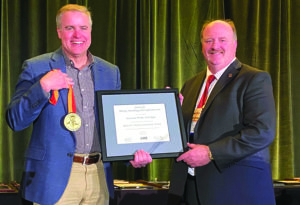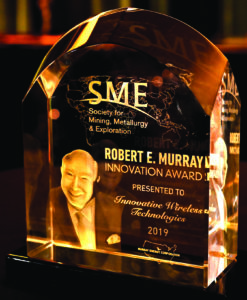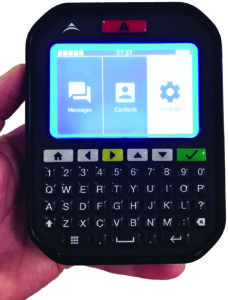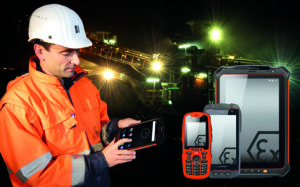Recent releases offer better communications, effective emergency alerts, real-time tracking, and other capabilities that improve safety and streamline rescue efforts
by jesse morton, technical writer
The evolution of communications technologies for underground mining has paralleled the evolution of underground mining jobs. Those jobs are now safer by an order of magnitude than were the mining jobs of yore. Some folks would argue that the relationship between the state of the communications technology underground and the level of job site safety underground is, in fact, one of cause and effect. A glance at the latest news from the biggest suppliers in the space reveals who those folks are and why they are confident that their solutions drive positive change in underground mining jobs, processes and rescue practices.

IWT CEO Eric Hansen says the company received the innovation award for answering a higher calling. (Photo: IWT)
Answering the Call
Innovative Wireless Technologies Inc. (IWT) received the Robert E. Murray Innovation Award as part of the keynote address for the annual convention of the Society for Mining, Metallurgy and Exploration (SME) in late February.
IWT CEO Eric Hansen told Coal Age that receiving the award was humbling. “First off, I can’t take any credit for it,” he said. “It is the hard-working, innovative engineers and folks on my team.”
Hansen said the award is recognition that the team serves a higher calling. “The reason we are doing this is greater than selling products,” he said. “Our hope is that we continue to work with our customers and our partners in the mining and mine rescue community to keep making better products that make mining safer and that make our customers profitable and successful. If they are successful, we are successful.”
Last year was the first year and it was given to the National Institute for Occupational Safety and Health.
“We are the first private entity to win this prestigious award,” Hansen said. “It is a huge honor.”
The award was given for IWT’s line of SENTINEL underground networking, communications and tracking solutions, used on a day-to-day basis for safety and operations and also for mine rescue responses.
Modular and scalable, SENTINEL is comprised of a series of small nodes that are deployed in a working section or throughout a mine that, combined, create a wireless communications network. It can support wireless voice, text, tracking, atmospheric monitoring, performance metrics and more, the company reported.
The mine rescue solution is specifically tailored to rapid and fast deployment, for when seconds count.
Over the years, SENTINEL evolved from a mobile safety system to a comprehensive, enterprise-level network for underground mining operations. “It started almost as an afterthought,” Hansen said. “We had this capability we’d developed for warfighting. After the Sago and Upper Big Branch disasters, we saw applicability to support the mining industry.”
The solution evolved from military technology to underground mining technology.
In underground mines, it proved popular, and feedback showed it could be used for applications beyond just safety and compliance. “The customers wanted a battery-powered solution in their working headings so, fairly quickly, we put out the SENTINEL Battery Mesh Node, and it was really well received,” Hansen said.
“More and more our customers started to use this product in a different way, really in a way it wasn’t initially designed to be used,” he said. “What piqued our interest is that they wanted to move quicker in their headings and longwalls.”
Ideal was a node that did not require power but had the same capabilities. “Mobility was a big drive as well as a focus on the SWaP (Size, Weight and Power) of the Solution,” Hansen said.
Cabled nodes gave rise to mobile battery-powered nodes, and as SENTINEL evolved so did the ways it could be used to support operations, Hansen said. “These early battery-powered nodes were the leading edge of our mine rescue products as mobility, weight and ease-of-use are major drivers.”
The mission to improve the capabilities of SENTINEL branched off a mission to perfect a data and analytics package, culminating in High Data Rate (HDR) SENTINEL Uniti Node. Combined, the solutions make possible “breakthrough step-function revolutions in new capability sets,” Hansen said.
Applications include optimizing traffic control, measuring workflow and fine-tuning work processes. The combination can help resolve key questions. “How can I better schedule work? Do I have a piece of equipment that is not being utilized that I could deploy to a different section?” Hansen said.
With the visibility supplied by SENTINEL and analytics, the data becomes visible and answers emerge, he said. “We’re excited about taking that data, and figuring out how that data becomes more useful for our customers,” he added.
History shows one way is in mine rescue.

The Robert E. Murray Innovation Award was given to NIOSH last year and IWT this year. The award recognizes individuals or organizations that advance mining through technical innovation. (Photo: IWT)
During his acceptance speech at SME, Hansen spoke about a mine that had deployed SENTINEL and used it after a roof fall crushed the limb of a miner. “The roof fall caused an amputation of the limb, and he was at high risk of bleeding out
right there in the working section,” Hansen said.
The SENTINEL infrastructure survived the fall and “continued to operate, monitor, and provide communications, tracking and situational awareness to the dispatcher post-incident,” he said.
A fellow miner at the site of the roof fall made a private, secure call and relayed HIPPA and personal medical information to the dispatcher.
“The dispatcher was able to look at the situational awareness display of his screen and immediately start dispatching first-aid resources and EMTs based on which ones were closest,” Hansen said. “In parallel, as the EMTs approached the location where the miner was down, the dispatcher was calling 911 and summoning above-ground resources and first responders.”
The SENTINEL-based system gave the dispatcher the visibility needed to order equipment movements to clear the exit path. “He was able to free the travel way to quickly get this injured miner out of the mine as soon as possible,” Hansen said.
Within six minutes, the miner was loaded on to a truck and being transported out of the mine. “The EMTs on the truck “were calling in vital life signs during the exit from the mine,” Hansen said. “For more than 10 minutes, those EMTs were on their networking gear, communicating blood pressure, oxygen level and heart rate,” he said. “They had uninterrupted communications.”
It took 11 minutes to get topside.
“As the paramedics flew in, they were amazed,” Hansen said. “They had all the information on this injured miner before they even landed,” he said. “They were shocked that the mine was able to provide all this information so they could bring all the first response gear they needed.”
The story shows the importance of innovation in underground communication systems, Hansen said.
“If they had run a legacy system with a wired backhaul and it got knocked out with the roof fall, they may not have been able to respond to the event at the pace that they were,” he said. Instead, “they had mobile nodes in their working sections. Nothing was interrupted in their service, which was a game-changer for their response.”
The story also speaks to the higher calling of the company. “These types of events don’t just affect the mine operation, they affect families, they affect kids and spouses,” Hansen said. “It still to this day chokes me up when I think about it. Positively impacting lives, families, kids, grandkids and spouses, that makes it all worthwhile.”

The MC2 is recently awarded IECex certification in Australia. It was designed with the texting generation in mind. (Photo: Strata Worldwide)
Rugged Handhelds for Texting Generation
Strata Worldwide announced the second-generation miner communicator (MC2), a handheld device that supports tracking texting, to include group texting, and has a full-feature keyboard and a large backlit LCD.
Pocket sized, and resembling an early generation Blackberry texting device, the MC2 operates on the
company’s 915-megahertz wireless mesh network, StrataConnect Wireless, and enables personnel location tracking and two-way communication between the surface and individuals underground.
Rugged and water resistant, the unit has a hard-button QWERTY keyboard that lights up, the company reported. A pouch that can be worn on the belt or suspenders is optional.
Strata said the device speaks to the current popularity of texting. “We saw the age demographic shifting in underground coal,” Rob Albinger, general manager, safety electronics, Strata, said. “Most people these days communicate on cell phones via text versus making voice calls.”
The MC2 offers several benefits over the MC1. For example, each device has an automatically updated directory that allows the user to search for others by name or department. “If you want to be able to contact somebody in maintenance or first aid, departmental contact information is all automatically organized and updated to simplify the search,” he said.
The device also allows the user to pinpoint the location of others within the mine. “In the old version, you would text to the surface and ask the operator for the location of a particular individual,” Albinger said. “Here you just type in that particular person’s name or that particular person’s profession and it will identify exactly where they are located.”
MC2 also supports group texts. For example, “you can have a supervisor or mechanics list,” he said. “If you have 200 men underground, you can divide them into groups, and then you can communicate with multiple people.”
MC2 also offers robust messaging ability in comparison to the predecessor model.
MC1 offered the ability to send canned, predetermined messages. Typically, the user would have as many as 60 messages to choose from. “They would scroll down, select and send,” Albinger said.
It also supported unique texts. “Users did have the ability to type out messages, but by using arrows to toggle through letters, very similar to the early generation Nokia texting phones,” Albinger said. “You would arrow over, find the letter, select. Arrow over, find the letter, select.”
With a full QWERTY keyboard, the MC2, in contrast, allows easy, speedy texting of original messages. It holds up to 500 canned messages. It also has LED indicators, red and green, that signal the type of received message.
“You receive alerts when you have messages and when there is some form of an emergency,” Albinger said. “Red LEDs alert you to the fact that there is an emergency or critical situation that requires immediate attention.”
The LED indicators help a critical message get read timely.
“A big advantage to having the MC2 rather than using two-way voice communication,” Albinger said, “is the clarity and directness of the message. The noise level underground may make it difficult, if not impossible, to know you have an incoming call, and then it could play a big part in whether or not you can hear what is being said. Moving to a quieter location takes time and interrupts workflow.”
The solution offers other key advantages over voice calls. Texting generates less data and so uses less bandwidth. With voice “you may experience dead spots,” Albinger said. “And it would require you to spend the time to walk out into an area where you can pick up a signal.”
On the MC2, incoming texts trigger a beep. “It is latching, so if that message goes unacknowledged then it will continue to beep,” Albinger said. “By default, it will beep every five minutes as a reminder,” he said. “That is a user-selectable feature.”
The solution provides a running record of written communications that can be used to help determine, after the fact, when exactly messages were sent and read. “All your messages are logged until you clear the cache, so if you have conversations between miners, you can go back and review those records,” Albinger said. “That data is stored on the server.”
MC2 also has tracking capabilities, giving exact locations of all users in the mine. The system collects ping information on every user and displays their location on the digital mine map. “Each MC2 sends a ping back every 60 seconds,” Albinger said.
“This feature plays a vital role in mine safety because mine operators have access to the location history and direction of travel of personnel in an emergency situation,” he said.
MC2 offers almost unbroken coverage over the StrataConnect network, which, Albinger said, “can cover the entire landscape of the mine, primary and secondary.”
StrataConnect hardware is a network of strategically placed wireless nodes, called CommNodes, each of which is powered by four D-cell batteries. The shoebox-size nodes typically are suspended inches from the mine roof. The signal strength between the nodes determines the placement of each.
The node network provides coverage that can be used to support several applications, including wireless communication and tracking, remote control, remote monitoring and emergency alert broadcasts. Simple and easy to install, the network requires “no cabling, no external antennas, and no battery backups,” Albinger said.
A number of customers with StrataConnect trialed the MC2 and provided feedback. “We initially had 500 units built,” Albinger said. “Feedback we received was positive and included some suggested improvements, which were made.”
Feedback also reveals the MC2 could even be used to communicate important productivity information and machine health data from operator to the back office.

IntelliZone’s new status screen provides troubleshooting functionality as well as in-cab directional zone information for mobile equipment operators. (Photo: Matrix Team)
Popular Prox System Gets Upgrades
Matrix Team released two new upgrade components for its popular IntelliZone proximity detection system.
The system, now in use on the vast majority of continuous miners in the U.S., has added onboard diagnostic capabilities via the new IntelliZone Status Screen and the Machine Mounted Locator.
Both components were designed to streamline use and maintenance of the system, improving performance and reducing downtime, Brian Jones, vice president of business development, Matrix Design Group, told Coal Age.
The status screen is an upgrade to the legacy in-cab directional display.
Jones described the new screen as a multipage interface that allows operators and maintenance personnel to quickly troubleshoot a system without use of another device on the section.
“At a glance, operators are able to determine the overall operational health of the system, as well as drill down to detailed diagnostic information,” Jones said. “It adds real-time onboard diagnostic display functionality, with the goal of simplifying
troubleshooting to reduce maintenance downtime.”
The Machine Mounted Locator mounts IntelliZone Locator technology on to a machine and in robust protective housing, Matrix reported. “In normal operation, it acts as a diagnostic monitoring system for the drivers and antennae,” Jones said. It basically allows the system to complete needed routine self-checks.
“It can also be used as an articulation detection tool to shift zones on articulated machinery that doesn’t have an available OEM output signal,” Jones said. Which means, he said, it can be used to further optimize zones.
Optimized zones is what distinguishes IntelliZone.
“IntelliZone’s SharpZone technology enables precise worker location around a piece of equipment,” Jones said. “The system allows zones to expand and contract based on a vehicle’s speed and direction and only along the path of travel, instead of overlapping into crosscuts or cutouts.”
SharpZone minimizes false alarms and allows long-range and through-curtain detection. “It conforms to the machine’s shape, speed and direction, providing maximum productivity,” Jones said. “And its high-quality products are rugged, durable, and designed to withstand the wear and tear of an underground mine.”
Released in Q2, 2009, IntelliZone disrupted the proximity-detection space in the U.S. by offering precise tracking and the ability to define customized, shaped zones around each machine, Matrix Group reported. “This X, Y tracking was revolutionary in the marketplace, particularly for MSHA-approved systems,” Jones said.
Primary hardware is a display or screen for operators; Drivers and antennae, which are integrated to the machine; and Locators, which are worn by workers or are mounted on equipment or elsewhere. “The Locator is compact, lightweight, simple to use, and powered by a rechargeable battery,” Jones said.
Systems and zones are configured using the IntelliView software, he said. The Drivers, typically four per machine, detect the Locators as they enter the zones. The Locators sound alerts the Drivers display alerts.
In a typical configuration, IntelliZone creates three types of zone: Caution, Operator and Shutdown.
In the Caution Zone, which is furthest from the machine, the Locator uses audible and visual alerts to warn personnel of potential danger.
In the Operator Zone, especially useful for shuttle car loading, the operator can work in a safe position near the machine without triggering warning alerts, the company reported.
In the Shutdown Zone, which is closest to the machine, movement of equipment is immediately disabled when a Locator is detected, and there is a constant tone warning on the Locator and flashing red light on the Driver. “Operation resumes when the Locator leaves the zone,” Jones said. “However, customers have implemented multiple other zones as needed.
Today, in the U.S. and South Africa, it is commonly found on continuous miners, shuttle cars, roof bolters, loaders, scoops and haulers. “The system has been installed on articulating haulage,” Jones said. “In South Africa, IntelliZone has been outfitted on more than 200 machines since its entry into the market there in 2016.”
Jones said there is a global uptick in adoption of proximity detection solutions. “Operations globally are beginning to utilize the equipment more and more, shifting from mandatory rule compliance to self-determination as a part of an overall safety or training initiative, or in some cases as a technical aid and in other cases as an engineering control.”
While the U.S. and South Africa have government mandates on deployment of proximity detection systems, demand is now springing up elsewhere.
“Countries like Australia have been working toward adoption for some time, with some more progressive companies moving forward with trial implementation of these systems,” Jones said. “In fact, an IntelliZone system trial is set to start soon in Queensland,” he said. “IntelliZone is now IECEx-approved and available globally.”

With a built-in battery that can go a day between charges, the i.safe MOBILE IS910.1 tablet is waterproof up to an hour and can support Android and Qualcomm Snapdragon. (Photo: i.safe MOBILE)
4G Tablets Survive Drops, Water, Dirt
i.safe MOBILE, maker of smartphones and tablets for use in extreme and industrial work environments, reported it is growing its footprint in the mining space. With customers in Australia, Russia and China, “the feedback we are getting is that the devices perform as expected and meet the customers’ needs,” Martin Haaf, CEO, i.safe MOBILE, told Coal Age.
Demand for the devices stems from their ability to be used for enterprise communications, management, and machine health monitoring applications. “These devices can manage data coming out of the automation process,” Haaf said. “One i.safe MOBILE device usually can replace several legacy devices.”
i.safe MOBILE devices are designed to withstand drops, impacts, dirt, dust, wear and water.
“We have specific-use glass, with a special glass on top if needed to withstand impacts to the glass itself so that the touch screen is working all of the time,” Haaf said.
The housing is made of an antistatic plastic. “It cannot be charged, create a discharge, emit a spark or ignite,” Haaf said. “The wall thickness of the device itself is much bigger compared to that of a consumer device.”
The devices run for a minimum of 10 hours on a complete charge. “They can last substantially longer,” Haaf said. “On the tablet, we have an integrated battery, and it runs 24 hours on a single complete charge.”
The phones can run lone-worker-protection and push-to-talk apps.
Lone-worker protection is gaining in popularity, Haaf said.
“Inside the units we have sensors that can detect a fall and fall angle,” he said. “If you fall from something, the phone will detect it and send out an alarm.”
The alarm first sounds on the phone itself, giving the user the opportunity to turn it off. “In case you do not stop the alarm, it will automatically call in the emergency and give your coordinates.”
i.safe MOBILE works with several push-to-talk providers.
Push-to-talk, typically a cloudbased app, allows one-to-one or one-to-multiple communications at the push of a button, similar to the action of two-way radios. “There can be messages and photos exchanged,” Haaf said. “The communications can be secured for mission critical applications.”
Other features include the ability to support management tools, such as maintenance applications. “That allows the user to have maintenance and inspection plans as applications,” Haaf said. “Which means it can be done wirelessly. The user gets a job on the smartphone screen. He does the job and sends back the message that everything is done. Then the next job comes over the screen.”
The phones offer tracking capabilities. “For underground, we have different solutions based on WiFi but also on Bluetooth low energy beacons,” Haaf said. “There is also an application that provides tracking information in three dimensions.”
Increasingly, the devices are sought by customers undergoing digitization. “We see some, but not many, companies in the world are very advanced in this area and they have a full digitization process running already.”
The company does not custom code apps. That is usually done by the equipment OEM or by IT personal at the operation, Haaf said.
The devices operate best in a 4G environment. “They can also operate in a 3G or 2G environment,” Haaf said, “but, of course, for data we need a 4G or WiFi solution.”
The devices require either 2.4-gigahertz (GHz) or 5-GHz WiFi. They are ATEX (European Union), IECEx (global), CSA (North America) and EAC (Russia) explosion-proof certified. They support Android, Bluetooth and Qualcomm Snapdragon; and come equipped with two cameras and an SOS key.


